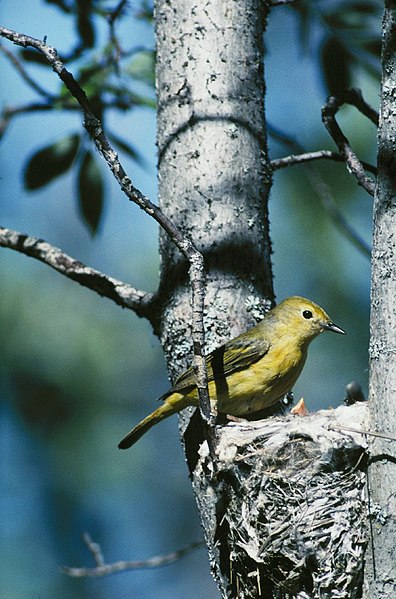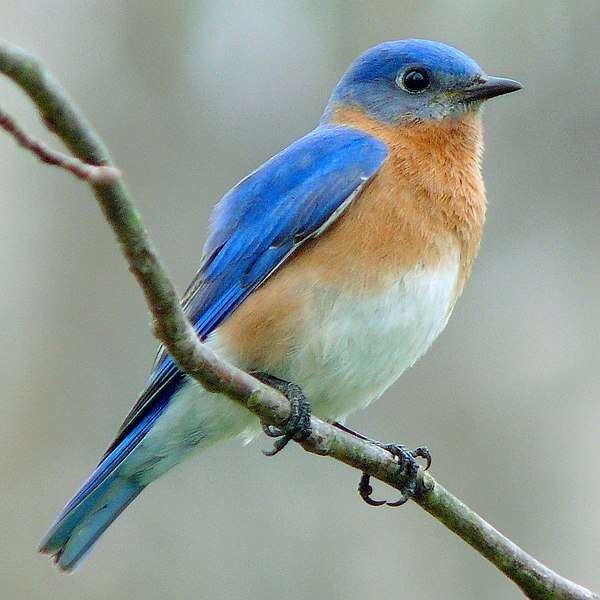 Birds all across the USA are now returning from their wintering grounds and will soon be visiting feeders and raising new families. Many migratory birds are threatened by loss of both summer and winter habitats, and by problems they encounter on route. Anything we can do to help migratory birds will also benefit resident species, and of course will enable us to more easily observe and enjoy them. Please consider the following suggestions.
Birds all across the USA are now returning from their wintering grounds and will soon be visiting feeders and raising new families. Many migratory birds are threatened by loss of both summer and winter habitats, and by problems they encounter on route. Anything we can do to help migratory birds will also benefit resident species, and of course will enable us to more easily observe and enjoy them. Please consider the following suggestions.
Native Vegetation and Dead Trees
Allow a portion of your yard to “remain wild” by encouraging native scrub, bushes and grasses. If you also have a garden and/or lawn, adding native plants will create an “edge effect” – a zone where different habits meet. Such areas, whether they be forest/field or lawn/scrub, always attract far more species than either habitat individually.
Dead trees are, for many animals, one of the most valuable of all natural resources, and among the scarcest. If it is safe to do so, allow dead trees to remain in place. Hollows will be used as nest sites or retreats by a number of specialists, including woodpeckers, flying squirrels, bats and screech owls. A surprising range of other birds may also take refuge in tree hollows during storms, and the insects that burrow into dead trees will attract a host of avian predators.
Gardening for Birds
In addition to encouraging native vegetation (please see above), you can also create an inviting bird habitat by growing favored food plants and those that attract insects. An added bonus is that many will be useful as foods for any pet birds you may keep (please see the article below for details). This article on  invertebrates-part-3/”>Reptile Gardens and Ponds will give you some idea of the diversity of invertebrates – many of which are important bird foods – that will flock to even the smallest areas when the right food plants, flowers and cover are present.
invertebrates-part-3/”>Reptile Gardens and Ponds will give you some idea of the diversity of invertebrates – many of which are important bird foods – that will flock to even the smallest areas when the right food plants, flowers and cover are present.
Whenever possible, limit pesticide use.While most are not directly toxic to birds, secondary poisoning is possible. This is especially likely for warblers and other insectivorous birds, and for the great many species that raise their young solely upon insects, earthworms and other invertebrates.
Pesticides that kill bees, butterflies and other pollinators will also affect the availability of fruits, buds and other important bird foods. Please see the article below for some ideas on pesticide alternatives.
Volunteer Programs
Become involved in volunteer surveys, nest-box installation programs and re-planting efforts; all are enjoyable and will, over time, add to the diversity of birds in the general area. The Great Backyard Bird Count and others operate during the winter, but the information they generate is valuable year-round (please see article below).
Consider also having your yard enrolled in the National Wildlife Federation Certified Wildlife Habitat Program
Clean Feeders, Baths and Bird Houses
Cleaning the structures that birds use will help to control parasites and certain diseases. Most importantly, refreshing your bird bath on a regular basis will prevent it from becoming a breeding ground for mosquitoes that transmit West Nile Virus and other diseases that may affect people.
Please check out our extensive line of bird baths, houses, feeders and foods for useful ideas and products.
Learn How to Help Injured Birds
 Spring always brings with it a host of weakened long-distance migrants and baby birds that seem in need of help. It’s important to bear in mind that injured birds always require veterinary attention, and are very difficult to care for at home. Also, many seemingly “abandoned” baby birds are actually fledging (leaving the nest) naturally and, although clumsy, do not need our help. Birds that truly have fallen for the nest are a full-time job to raise, and require the attention of an experienced hand.
Spring always brings with it a host of weakened long-distance migrants and baby birds that seem in need of help. It’s important to bear in mind that injured birds always require veterinary attention, and are very difficult to care for at home. Also, many seemingly “abandoned” baby birds are actually fledging (leaving the nest) naturally and, although clumsy, do not need our help. Birds that truly have fallen for the nest are a full-time job to raise, and require the attention of an experienced hand.
Fortunately, there are a number of resources one can turn to when faced with an avian emergency, and also may ways to learn how to become involved in bird rehabilitation. Please see my article on Helping Abandoned Birds to learn more.
Further Reading
How Birders can Contribute to Conservation
 That Bird Blog – Bird Care and History for Pet Birds
That Bird Blog – Bird Care and History for Pet Birds



